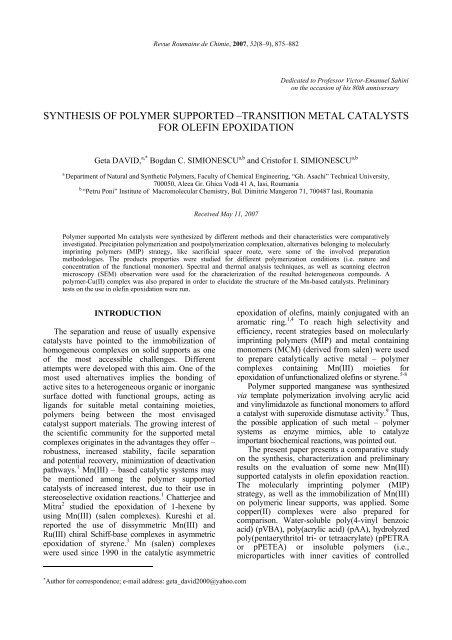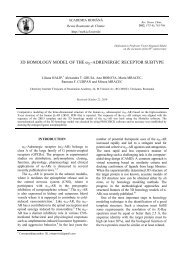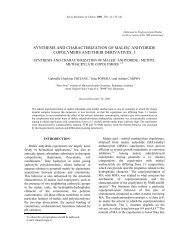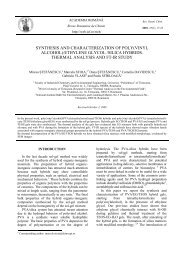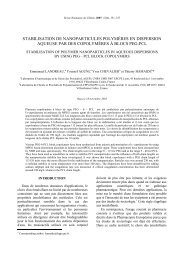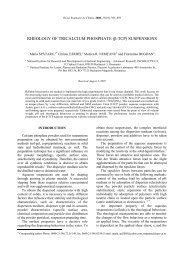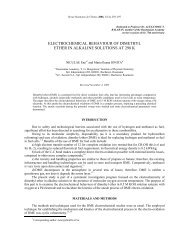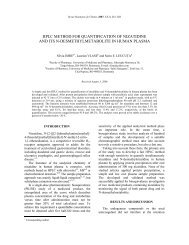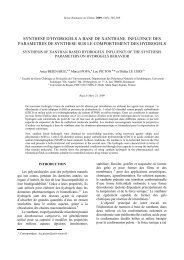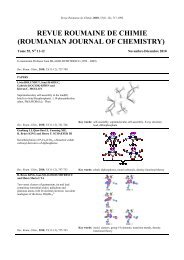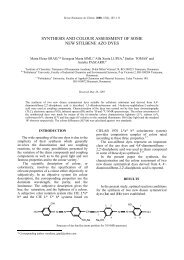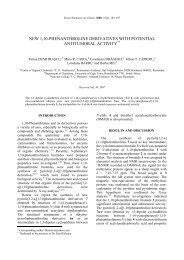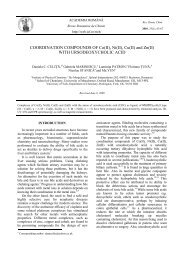synthesis of polymer supported âtransition metal catalysts for olefin ...
synthesis of polymer supported âtransition metal catalysts for olefin ...
synthesis of polymer supported âtransition metal catalysts for olefin ...
You also want an ePaper? Increase the reach of your titles
YUMPU automatically turns print PDFs into web optimized ePapers that Google loves.
Revue Roumaine de Chimie, 2007, 52(8–9), 875–882<br />
Dedicated to Pr<strong>of</strong>essor Victor-Emanuel Sahini<br />
on the occasion <strong>of</strong> his 80th anniversary<br />
SYNTHESIS OF POLYMER SUPPORTED –TRANSITION METAL CATALYSTS<br />
FOR OLEFIN EPOXIDATION<br />
Geta DAVID, a,* Bogdan C. SIMIONESCU a,b and Crist<strong>of</strong>or I. SIMIONESCU a,b<br />
a<br />
Department <strong>of</strong> Natural and Synthetic Polymers, Faculty <strong>of</strong> Chemical Engineering, “Gh. Asachi” Technical University,<br />
700050, Aleea Gr. Ghica Vodă 41 A, Iasi, Roumania<br />
b<br />
“Petru Poni” Institute <strong>of</strong> Macromolecular Chemistry, Bul. Dimitrie Mangeron 71, 700487 Iasi, Roumania<br />
Received May 11, 2007<br />
Polymer <strong>supported</strong> Mn <strong>catalysts</strong> were synthesized by different methods and their characteristics were comparatively<br />
investigated. Precipitation <strong>polymer</strong>ization and post<strong>polymer</strong>ization complexation, alternatives belonging to molecularly<br />
imprinting <strong>polymer</strong>s (MIP) strategy, like sacrificial spacer route, were some <strong>of</strong> the involved preparation<br />
methodologies. The products properties were studied <strong>for</strong> different <strong>polymer</strong>ization conditions (i.e. nature and<br />
concentration <strong>of</strong> the functional monomer). Spectral and thermal analysis techniques, as well as scanning electron<br />
microscopy (SEM) observation were used <strong>for</strong> the characterization <strong>of</strong> the resulted heterogeneous compounds. A<br />
<strong>polymer</strong>-Cu(II) complex was also prepared in order to elucidate the structure <strong>of</strong> the Mn-based <strong>catalysts</strong>. Preliminary<br />
tests on the use in <strong>olefin</strong> epoxidation were run.<br />
INTRODUCTION ∗<br />
The separation and reuse <strong>of</strong> usually expensive<br />
<strong>catalysts</strong> have pointed to the immobilization <strong>of</strong><br />
homogeneous complexes on solid supports as one<br />
<strong>of</strong> the most accessible challenges. Different<br />
attempts were developed with this aim. One <strong>of</strong> the<br />
most used alternatives implies the bonding <strong>of</strong><br />
active sites to a heterogeneous organic or inorganic<br />
surface dotted with functional groups, acting as<br />
ligands <strong>for</strong> suitable <strong>metal</strong> containing moieties,<br />
<strong>polymer</strong>s being between the most envisaged<br />
catalyst support materials. The growing interest <strong>of</strong><br />
the scientific community <strong>for</strong> the <strong>supported</strong> <strong>metal</strong><br />
complexes originates in the advantages they <strong>of</strong>fer –<br />
robustness, increased stability, facile separation<br />
and potential recovery, minimization <strong>of</strong> deactivation<br />
pathways. 1 Mn(III) – based catalytic systems may<br />
be mentioned among the <strong>polymer</strong> <strong>supported</strong><br />
<strong>catalysts</strong> <strong>of</strong> increased interest, due to their use in<br />
stereoselective oxidation reactions. 1 Chatterjee and<br />
Mitra 2 studied the epoxidation <strong>of</strong> 1-hexene by<br />
using Mn(III) (salen complexes). Kureshi et al.<br />
reported the use <strong>of</strong> dissymmetric Mn(III) and<br />
Ru(III) chiral Schiff-base complexes in asymmetric<br />
epoxidation <strong>of</strong> styrene. 3 Mn (salen) complexes<br />
were used since 1990 in the catalytic asymmetric<br />
epoxidation <strong>of</strong> <strong>olefin</strong>s, mainly conjugated with an<br />
aromatic ring. 1,4 To reach high selectivity and<br />
efficiency, recent strategies based on molecularly<br />
imprinting <strong>polymer</strong>s (MIP) and <strong>metal</strong> containing<br />
monomers (MCM) (derived from salen) were used<br />
to prepare catalytically active <strong>metal</strong> – <strong>polymer</strong><br />
complexes containing Mn(III) moieties <strong>for</strong><br />
epoxidation <strong>of</strong> unfunctionalized <strong>olefin</strong>s or styrene. 5-8<br />
Polymer <strong>supported</strong> manganese was synthesized<br />
via template <strong>polymer</strong>ization involving acrylic acid<br />
and vinylimidazole as functional monomers to af<strong>for</strong>d<br />
a catalyst with superoxide dismutase activity. 9 Thus,<br />
the possible application <strong>of</strong> such <strong>metal</strong> – <strong>polymer</strong><br />
systems as enzyme mimics, able to catalyze<br />
important biochemical reactions, was pointed out.<br />
The present paper presents a comparative study<br />
on the <strong>synthesis</strong>, characterization and preliminary<br />
results on the evaluation <strong>of</strong> some new Mn(III)<br />
<strong>supported</strong> <strong>catalysts</strong> in <strong>olefin</strong> epoxidation reaction.<br />
The molecularly imprinting <strong>polymer</strong> (MIP)<br />
strategy, as well as the immobilization <strong>of</strong> Mn(III)<br />
on <strong>polymer</strong>ic linear supports, was applied. Some<br />
copper(II) complexes were also prepared <strong>for</strong><br />
comparison. Water-soluble poly(4-vinyl benzoic<br />
acid) (pVBA), poly(acrylic acid) (pAA), hydrolyzed<br />
poly(pentaerythritol tri- or tetraacrylate) (pPETRA<br />
or pPETEA) or insoluble <strong>polymer</strong>s (i.e.,<br />
microparticles with inner cavities <strong>of</strong> controlled<br />
∗ Author <strong>for</strong> correspondence; e-mail address: geta_david2000@yahoo.com
876 Geta David et al.<br />
dimension and functionality) were used as a<br />
support. Screening a series <strong>of</strong> <strong>metal</strong> complexes <strong>for</strong><br />
<strong>olefin</strong> epoxidation is expected to allow the<br />
identification <strong>of</strong> several <strong>catalysts</strong> with improved<br />
activity and selectivity.<br />
EXPERIMENTAL<br />
Materials<br />
Acrylic acid (anhydrous, AA – Fluka) was purified by<br />
vacuum distillation, dried on MgSO 4 and stored over molecular<br />
sieves at 4˚C.<br />
Divinyl benzene (DVB – Aldrich), pentaerythritol triacrylate<br />
(PETRA – Aldrich), pentaerythritol tetraacrylate (PETEA –<br />
Aldrich) were washed with 1M aqueous sodium hydroxide to<br />
remove inhibitor, washed with water until neutral pH, dried on<br />
MgSO 4 , passed through alumina columns and stored on<br />
molecular sieves at 4˚C.<br />
4-Vinylbenzoic acid (VBA – Aldrich), manganese(III)<br />
acetate dihydrate (Mn(OAc) . 3 2H 2 O – Aldrich), copper acetate<br />
(Cu(OAc) . 2 nH 2 O – Aldrich), 2,2’-azo-bis(isobutyronitrile)<br />
(AIBN – Aldrich) were used without further purification. The<br />
solvents (methanol, ACS spectrophotometric grade – Aldrich,<br />
anhydrous ethanol – Kenetyl AB, anhydrous toluene –<br />
Aldrich, acetonitrile, HPLC grade, ACN – Aldrich) and<br />
hydrochloric acid (37%, Labasco) were used as received.<br />
Iodosobenzoic acid and stilbene (Aldrich) were used<br />
without further purification. All aqueous analysis solutions<br />
were prepared using double-distilled water.<br />
Equipment and instrumentation<br />
IR spectra were recorded using a Spectrum 2000 (Perkin<br />
Elmer) FT-IR spectrometer. The obtained <strong>polymer</strong>ic particles<br />
were characterized using a Jeol JSM-5400 scanning electron<br />
microscope (SEM). Samples were previously sputtered with a<br />
Pt thin protecting film (Denton vacuum, Desk II sputtering<br />
system). The particle size and size distribution were calculated<br />
with the <strong>for</strong>mula:<br />
Dn = ∑NiDi/∑Ni , Dw = ∑NiDi 4 /∑NiDi 3 , PI = Dw/Dn<br />
Thermal characterisation <strong>of</strong> the studied materials (differential<br />
scanning calorimetry – DSC and thermogravimetric analysis –<br />
TGA) was per<strong>for</strong>med with a Mettler DSC 820 and a<br />
TGA/SDTA 851 e instrument, respectively. Be<strong>for</strong>e testing, the<br />
samples were heated at 110˚C to eliminate the absorbed<br />
moisture. The registration was carried out under nitrogen flow<br />
(10 and 50 l/min, respectively) by using a heating rate <strong>of</strong><br />
10˚C/min.<br />
Evaluation <strong>of</strong> the manganese ions content in residual and<br />
washing solutions was per<strong>for</strong>med by spectrophotometric<br />
measurements at λ = 524 nm.<br />
Polymer supports preparation<br />
MIP <strong>synthesis</strong> by the sacrificial spacer method<br />
The application <strong>of</strong> the sacrificial spacer method 10 involved<br />
the development <strong>of</strong> a three step synthetic procedure, consisting<br />
<strong>of</strong> (a) co<strong>polymer</strong>ization <strong>of</strong> the crosslinker (DVB) with the<br />
functional monomer (PETRA or PETEA), (b) hydrolysis <strong>of</strong><br />
the resulted co<strong>polymer</strong> and (c) complexation <strong>of</strong> the<br />
hydrolyzed sample with manganese salt.<br />
Co<strong>polymer</strong>s <strong>of</strong> PETRA and PETEA with DVB were<br />
prepared in ethanol/toluene 9:1 v/v mixture, using AIBN as an<br />
initiator (2 wt % relative to total monomer). A concentration<br />
<strong>of</strong> 3.5% wt/v total monomer/solvent mixture was adopted.<br />
Four different molar ratios were used, considering the final<br />
composition <strong>of</strong> the inorganic/organic hybrid material and the<br />
feed compounds involved (crosslinker/functional monomer/<br />
manganese salt), i. e. 92/4/4, 80/10/10, 70/15/15 and 60/20/20,<br />
respectively. The reaction mixtures were purged 10 min with<br />
nitrogen and then were maintained under inert atmosphere at<br />
60˚C, with stirring (1000 r/min), <strong>for</strong> 6h. The resulted <strong>polymer</strong><br />
particles were separated by centrifugation, washed with<br />
methanol and acetone to remove the non-reacted monomer,<br />
dried in vacuum, weighed and characterized.<br />
The <strong>polymer</strong> particles were then subjected to alkaline<br />
hydrolysis in aqueous NaOH solution (2.5 wt % co<strong>polymer</strong><br />
particles in 2N NaOH solutions in 1:2 v/v water/methanol<br />
mixture), or with sodium alcoholate in methanol, at reflux<br />
temperature. The hydrolyzed microparticles were washed with<br />
10% HCl solution and distilled water until neutral pH. The<br />
usual yield was <strong>of</strong> 75-90%.<br />
Homo<strong>polymer</strong>s <strong>synthesis</strong><br />
Water-soluble linear <strong>polymer</strong>s bearing carboxylic<br />
functional groups, able to interact with the <strong>metal</strong> (manganese<br />
or copper) ions, were synthesized by the <strong>polymer</strong>ization <strong>of</strong> the<br />
appropriate monomers, i.e. acrylic acid or 4-vinylbenzoic acid,<br />
in benzene solution (10 wt %), at 60ºC, under inert atmosphere<br />
(N 2 ), <strong>for</strong> 4 and 20 h, respectively. AIBN (4 wt % with respect<br />
to monomer) was used as initiator. The crude products were<br />
washed with benzene and acetone, separated by centrifugation,<br />
dried and characterized. Yield: 97% and 90%, respectively.<br />
The acrylic monomers PETRA and PETEA were<br />
<strong>polymer</strong>ized in alcohol/toluene mixtures (9/1 v/v) in similar<br />
conditions. Then they were hydrolyzed with NaOH solution<br />
(2.5 wt % co<strong>polymer</strong> particles in 2N NaOH solutions in 1:2<br />
v/v water/methanol mixture). The hydrolyzed homo<strong>polymer</strong>s<br />
were precipitated first with acetone and then carefully washed<br />
with 5N HCl and acetone/water mixture. Yield: 70%.<br />
Preparation <strong>of</strong> the resin complexes<br />
For the complexation <strong>of</strong> the p(PETRA-co-DVB) and<br />
p(PETEA-co-DVB) hydrolyzed <strong>polymer</strong> particles, solutions <strong>of</strong><br />
10 mg/ml <strong>of</strong> Mn(OAc) 3 .2H 2 O in ACN were used, while <strong>for</strong><br />
homo<strong>polymer</strong>s complexation (pAA, pVBA, pPETEA, pPETRA)<br />
the solutions salt content was raised to 20 mg/ml. The reaction<br />
mixtures were maintained under stirring <strong>for</strong> 6h at 60°C and<br />
10h at room temperature. Periodically, inert gas was purged in<br />
order to remove the resulted acetic acid.<br />
The prepared complexes were separated by centrifugation<br />
and extracted with acetonitrile. When uptake <strong>of</strong> the manganese<br />
salt wasn’t total, the washing solutions were submitted to<br />
photocolorimetric titration.<br />
To obtain the Cu(II) complex, the sodium <strong>polymer</strong> salt<br />
was submitted to an ion-exchange reaction with Cu acetate in<br />
an aqueous solution. A batch method was used. 0.8 g pPETRA<br />
– Na salt – were dispersed in 20 ml aqueous solution<br />
containing 0.772 g Cu(OAc) 2 by 10 min sonnication and the<br />
mixture was stirred at room temperature <strong>for</strong> 24h.<br />
A modification <strong>of</strong> particle dimensions took place, smaller,<br />
light blue coloured fine new particles being <strong>for</strong>med. A<br />
complete Cu(II) uptake took place. The product was separated<br />
by centrifugation, washed repeatedly with water, dried, analyzed<br />
by FT-IR and thermal techniques.
Olefin epoxidation 877<br />
Epoxidation tests<br />
0.1 g Mn-<strong>supported</strong> catalyst was dispersed in 5 ml<br />
dichloromethane and stirred <strong>for</strong> 30 min at room temperature.<br />
1 mmol stilbene and 0.1 mmol oxidant reactive (iodosobenzoic<br />
acid) were then added dropping-wise and the reaction was<br />
continued with stirring <strong>for</strong> 2h. The reaction development was<br />
monitorized by thin layer chromatography (TLC), using<br />
cis-stilbene and trans-stilbene (Fluka) as standard samples.<br />
RESULTS AND DISCUSSION<br />
Supported <strong>catalysts</strong> by molecularly imprinting<br />
<strong>polymer</strong> technique. Sacrificial spacer alternative<br />
One way to overcome the limitations <strong>of</strong><br />
conventional molecular imprinting is to use an<br />
approach where the underlying chemistry is not<br />
sensitive to the presence <strong>of</strong> water. Byström et al. 11<br />
prepared divinyl benzene-based <strong>polymer</strong>ic beads<br />
with sterol acrylates by aqueous suspension<br />
<strong>polymer</strong>ization, followed by the conversion <strong>of</strong> the<br />
resulting co<strong>polymer</strong>s to “template <strong>polymer</strong>ic<br />
reducing agents” by reductive cleavage <strong>of</strong> the<br />
acrylate ester bond and attachment <strong>of</strong> the <strong>metal</strong><br />
hydride center to the resultant hydroxyl groups.<br />
The produced compounds showed a high degree <strong>of</strong><br />
stereochemical control in the reduction <strong>of</strong> steroid<br />
ketones.<br />
Here, the presynthesized functional <strong>polymer</strong>ic<br />
support intended <strong>for</strong> the catalytic complex was<br />
prepared by the co<strong>polymer</strong>ization <strong>of</strong> tri- or<br />
tetrafunctional pentaerythritol acrylates (PETRA or<br />
PETEA) with divinyl benzene, followed by<br />
hydrolysis <strong>of</strong> the esteric groups to carboxylic ones<br />
and complexation <strong>of</strong> the chelating groups inner the<br />
<strong>for</strong>med cavities. The co<strong>polymer</strong>ization data and the<br />
characteristics <strong>of</strong> the poly(acrylate-co-DVB)<br />
particles are compiled in Table 1.<br />
As can be seen, the size <strong>of</strong> the poly(PETEA-co-<br />
DVB) particles is decreasing from sample 4,4T to<br />
20,4T, due to an increased compactness, related to<br />
an increased content in the polyfunctional acrylate<br />
units. As revealed by SEM observations, all<br />
generated particles are uni<strong>for</strong>m and have a compact<br />
structure as compared to the hydrolyzed particles,<br />
which have an increased porosity (Fig. 1).<br />
a<br />
b<br />
Fig. 1 – SEM microphotographs <strong>of</strong> co<strong>polymer</strong> particles (a) be<strong>for</strong>e (sample 2) and (b) after hydrolysis (sample 8).<br />
The hydrolysis process was monitored by<br />
FT-IR spectrometry. As can be seen from the<br />
spectra <strong>of</strong> the initial co<strong>polymer</strong>s and <strong>of</strong> the<br />
hydrolysed products presented in Fig. 2 (a, b) the<br />
peak situated at 1731.4 cm -1 in the initial sample,<br />
ascertained to the esteric C=O groups, was<br />
replaced by a new peak situated at 1703-1705 cm -1 ,<br />
<strong>of</strong> higher intensity, due to the C=O stretching in<br />
the carboxylic groups. The peaks specific to the<br />
C-O-C stretching in the polyacrylates from 1253,<br />
1152 and 1062 also disappeared, being replaced by<br />
a large band, <strong>of</strong> lower intensity, in the 1230-1170 cm -1<br />
range.<br />
The hydrolysed compounds were then complexed<br />
with appropriate amounts <strong>of</strong> manganese acetate<br />
(equivalent to Mn(III) complexes) in absolute<br />
ethanol, under inert atmosphere. All the obtained<br />
complexes present characteristic colours (given by<br />
the used <strong>metal</strong>lic salt, totally different from the<br />
initial <strong>polymer</strong>, which is white in the solid state).<br />
The observed colours varied from beige to brown,<br />
with increasing concentration <strong>of</strong> added manganese.<br />
The hybrid materials were characterized by<br />
spectral technique and thermal analysis. In the FT-<br />
IR spectra the complexation is confirmed by the<br />
appearance <strong>of</strong> specific signals <strong>of</strong> increased<br />
intensity situated at 1557 cm -1 , 1415 cm -1 , 657 cm -1<br />
and 616 cm -1 (Fig. 2c).<br />
The thermostability <strong>of</strong> the coordinated<br />
complexes decreases as compared to the initial<br />
<strong>polymer</strong> support (Fig. 3) and with increasing the<br />
<strong>metal</strong> content (Fig. 4).
878 Geta David et al.<br />
Fig. 2 – FT-IR spectra <strong>of</strong> samples based on co<strong>polymer</strong> 15,4T:<br />
a) initial, b) after hydrolysis, c) after complexation (sample 6).<br />
Fig. 3 – Typical thermograms <strong>of</strong> samples based on co<strong>polymer</strong> 20,4T:<br />
a) the initial co<strong>polymer</strong>; b) the hydrolysed <strong>for</strong>m and c) the resulting complex with manganese
Olefin epoxidation 879<br />
Fig. 4 – Typical thermograms <strong>of</strong> the complexed samples (a) 4,3T; (b) 20,4T; (c) 40,4T.<br />
Table 1<br />
Co<strong>polymer</strong>ization <strong>of</strong> PETRA and PETEA with DVB. Characteristics <strong>of</strong> the Mn-hydrolyzed <strong>polymer</strong> complex<br />
No. Code Co<strong>polymer</strong> particles Complex<br />
Functional monomer Crosslinker η a Dn Dw PI Mn b<br />
PETRA PETEA<br />
(g ) ( g)<br />
(g) (%) (µm) (µm)<br />
(%)<br />
1 4,3T 0.12 1.20 84 1.4 1.5 1.06 1.6<br />
2 4,4T 0.14 1.20 75 2.8 3.8 1.34 2.1<br />
3 10,3T 0.30 1.04 67 1.7 2.2 1.30 3,1<br />
4 10,4T 0.35 1.04 73 1.7 1.9 1.05 3.2<br />
5 15,3T 0.45 0.91 89 1.9 2.3 1.20 3.2<br />
6 15,4T 0.52 0.91 86 2.5 3.1 1.24 3.4<br />
7 20,3T 0.60 0.78 87 2.2 3.0 1.38 6.0<br />
8 20,4T 0.70 0.78 85 1.9 2.0 1.05 5.8<br />
9 40,4T 1.40 0.26 90 2.0 2.1 1.05 8.5<br />
a - <strong>polymer</strong>ization yield<br />
b - analytic determination<br />
Concentrated complexes<br />
as <strong>polymer</strong> <strong>supported</strong> <strong>catalysts</strong> in epoxidation<br />
To elucidate the structure <strong>of</strong> the complex<br />
involved and to conclude on the effect <strong>of</strong> shape<br />
and composition <strong>of</strong> the <strong>polymer</strong> chain used as<br />
support on the catalytic efficiency <strong>of</strong> the resulting<br />
material, a comparative study on four<br />
homo<strong>polymer</strong>s – poly(4-vinylbenzoic acid)<br />
(pVBA), poly(acrylic acid) (pAA), hydrolysed<br />
poly(pentaerythritol tetraacrylate) (pPETEA) and<br />
poly(pentaerythritol triacrylate) (pPETRA) – was
880 Geta David et al.<br />
per<strong>for</strong>med. In the last case, the complex with<br />
copper acetate was also investigated with the aim<br />
to better understand the Mn-<strong>polymer</strong> complex<br />
structure and behaviour.<br />
Retention by chelating may be accomplished in<br />
virtue <strong>of</strong> the presence <strong>of</strong> one or more donor atoms<br />
able to coordinate the polyvalent <strong>metal</strong> ions.<br />
Coordination or ion-exchange reactions were used<br />
to generate the <strong>metal</strong>-ligand chelates, i.e. the Mn –<br />
<strong>polymer</strong> and Cu – <strong>polymer</strong> complexes,<br />
respectively. In the first case, the reactions were<br />
carried out in acetonitrile solution at moderate<br />
temperature (60-65ºC), in inert atmosphere, the<br />
equilibrium shifting to complex <strong>for</strong>mation being<br />
achieved by periodic elimination <strong>of</strong> generated<br />
CH 3 COOH from the system (by nitrogen purge).<br />
For the same reason a high concentration <strong>of</strong> the<br />
reactants in the system was adopted. The Cu<br />
complex with hydrolyzed poly(pentaerythritol<br />
triacrylate) was obtained by an ion-exchange<br />
reaction in aqueous solution.<br />
The main characteristics <strong>of</strong> the realized<br />
materials are presented in Table 2.<br />
Table 2<br />
Homo<strong>polymer</strong>s complexes characteristics<br />
Code Homo<strong>polymer</strong> support Hybrid <strong>metal</strong>-<strong>polymer</strong> microparticles<br />
Homo<strong>polymer</strong>s<br />
Yield a Dn PI Cu b Mn b Colour<br />
(%) (nm) (%) (%)<br />
pVBA Poly(4-vinylbenzoic acid) 96 3.3 1.3 12 dark brown<br />
pAA Poly(acrylic acid) 75 3.5 1.4 11 dark brown<br />
pPETRA Hydrolyzed poly(pentaerythritol triacrylate) 95 1.5 1.1 31<br />
intense blue<br />
85 3.1 1.2<br />
30 dark brown<br />
pPETEA Hydrolyzed poly(pentaerythritol tetraacrylate) 90 2.5 1.3 32 dark brown<br />
a - <strong>polymer</strong>ization yield<br />
b - analytic determination<br />
The products structure was confirmed by<br />
investigations per<strong>for</strong>med by FT-IR technique (Fig.<br />
5) and thermal analysis (Fig. 6)<br />
The resulted complexes present similar<br />
characteristics. In the FT-IR spectra (Fig. 5) the<br />
main signals ascertained to manganese complexes<br />
<strong>for</strong>mation are situated at 1530 -1560 cm -1 and in<br />
the 1393 - 1420 cm -1 range (1561 cm -1 , 1420 cm -1 –<br />
pAA complex; 1553 cm -1 , 1393 cm -1 – pVBA<br />
complex; 1556 cm -1 , 1420 cm -1 – hydrolyzed<br />
pPETRA complex, 1530 cm -1 , 1400 cm -1 -<br />
hydrolyzed pPETEA complex) attributed to ν as and<br />
ν s (O-C=O) mode in the newly <strong>for</strong>med carboxylate<br />
groups. Specific are also the signals in the 600 -<br />
660 cm -1 domain, ascertained to Mn presence, i. e.<br />
δ O-C=O and ν Mn-O (667 cm -1 , 615 cm -1 – pAA<br />
complex; 662 cm -1 , 618 cm -1 – pVBA complex;<br />
657 cm -1 , 615 cm -1 – hydrolyzed pPETRA<br />
complex; 676 cm -1 , 615 cm -1 – hydrolyzed<br />
pPETEA complex). The presence <strong>of</strong> the signals at<br />
1707 cm -1 and 1695 cm -1 in the spectra <strong>of</strong> the<br />
complexes <strong>for</strong>med with pAA and pVBA was<br />
related to the presence <strong>of</strong> uncomplexed, free<br />
COOH groups. However, almost 97 % <strong>of</strong> the<br />
added equivalent amount <strong>of</strong> Mn(III) salt was<br />
consumed. The signals situated at 1730 cm -1 and<br />
1149 cm -1 , attributed to ν C=O and ν C-O-C<br />
stretching vibrations in pPETRA and pPETEA<br />
esteric groups, disappeared. Also, the signal bands<br />
specific to acrylic compounds from 903, 831,<br />
797.5 cm -1 , were replaced, according to the<br />
previously mentioned data.<br />
According to the spectroscopic criterium 12 one<br />
may assume that a bidentate, polynuclear<br />
structured coordinative complex was generated.<br />
As compared to the Cu(OAc) . 2 nH 2 O specific<br />
bands in the FT-IR spectrum <strong>of</strong> the Cupoly(pentaerythritol<br />
triacrylate) complex, the<br />
signals situated at 1604.5 cm -1 and 1445 cm -1<br />
(multiplet), attributed to ν as and ν s (O-C=O)<br />
stretching vibrations in the original salt, are shifted<br />
to higher frequencies, i.e 1561 cm -1 and 1407.5 cm -<br />
1<br />
(Fig. 5D). A similar trend can be observed in the<br />
600-700 cm -1 range. The signals at 692 cm -1 and<br />
628.5 cm -1 were replaced by signals situated at<br />
682.4 cm -1 and 593 cm -1 . The signals situated at<br />
3440 and 3333 cm -1 are ascertained to the water<br />
included in the complex structure. Thus, it may be<br />
concluded that the equivalence <strong>of</strong> the two<br />
coordinated groups is maintained in the generated<br />
Cu-<strong>polymer</strong> complex.<br />
The proposed structures are confirmed by the<br />
DSC and TGA data (Fig. 6). Thus, while the<br />
decomposition <strong>of</strong> poly(pentaerytritol triacrylate)<br />
homo<strong>polymer</strong> takes place in a single step (89%<br />
weight loss) in the 370-460ºC range, its Mn
Olefin epoxidation 881<br />
complex presents a more complex decomposition<br />
process: first, a 4% weight loss, attributed to the<br />
crystallization water, takes place at 225-227ºC, and<br />
then a 40.5% weight loss, ascertained to the<br />
decomposition <strong>of</strong> the carboxyl ligand groups, can<br />
be observed in two steps situated at 250-340ºC and<br />
380-450ºC. The residual amount <strong>of</strong> about 53%,<br />
decomposing after 500ºC, mainly corresponds to<br />
Mn oxides.<br />
A<br />
B<br />
C<br />
Fig. 5 – FT-IR spectra <strong>of</strong>: A: a) poly (acrylic acid); b) the corresponding complex with Mn; B: a) poly(4-vinyl benzoic acid); b) its<br />
complex with Mn; C: a) poly(pentaerythritol triacrylate); b) the complex <strong>of</strong> hydrolyzed poly(pentaerythritol triacrylate) with Mn; c) the<br />
complex <strong>of</strong> the hydrolyzed poly(pentaerythritol tetraacrylate) with Mn; D: a) Cu(OAc) 2 . nH 2 O; b) Cu(II) – hydrolyzed<br />
poly(pentaerythritol triacrylate) complex.<br />
D<br />
Fig. 6 – Typical thermograms <strong>for</strong>: a) poly(penthaerythritol triacrylate), b) Cu(II)<br />
– hydrolyzed poly(pentaerythritol triacrylate) complex, c) Mn – hydrolyzed<br />
poly(pentaerythritol triacrylate) complex.
882 Geta David et al.<br />
For the Cu-poly(pentaerytritol triacrylate)<br />
complex the destruction <strong>of</strong> the two equivalent<br />
ligand groups linked to the Cu(II) ions takes place<br />
in the 195-235ºC range (weight loss, 18.6%) after<br />
the elimination <strong>of</strong> water (5% crystallization water).<br />
The weight loss process is connected with the<br />
strong endothermic effects observed in the DSC<br />
plot. The residual amount <strong>of</strong> 77% at 500 ºC is<br />
related to the high content in inorganic material.<br />
Preliminary tests in <strong>olefin</strong> epoxidation <strong>of</strong><br />
stilbene 13 gave a relatively low yield (40%) when<br />
sample 9 (Table 1) was used as a catalyst. However,<br />
yields higher than 70% were obtained <strong>for</strong> the Mn<br />
based complexes <strong>of</strong> poly(acrylic acid) and<br />
hydrolysed poly(pentaerythritol triacrylate), with a<br />
high stereoselectivity in the last case <strong>for</strong> the trans<br />
isomer.<br />
Further studies are in progress. The copper<br />
catalyst, considered as a possible alternative, will<br />
be also tested <strong>for</strong> comparison.<br />
CONCLUSION<br />
Two <strong>synthesis</strong> alternatives were applied in<br />
order to achieve the <strong>synthesis</strong> <strong>of</strong> <strong>metal</strong> - <strong>polymer</strong><br />
<strong>supported</strong> <strong>catalysts</strong>: 1) use <strong>of</strong> a molecular imprinting<br />
<strong>polymer</strong> strategy (sacrificial spacer route) followed<br />
by complexation with appropriate <strong>metal</strong> salts, and<br />
2) direct complexation <strong>of</strong> soluble <strong>polymer</strong> supports.<br />
The complexation is an equilibrium process and can<br />
be controlled by reaction parameters (temperature,<br />
reaction duration, concentration <strong>of</strong> the partners,<br />
periodic elimination <strong>of</strong> the generated low molecular<br />
compound – the acetic acid).<br />
A comparison between the complexes generated<br />
with contribution <strong>of</strong> Mn(III) or Cu(II) salts pointed<br />
on the increase <strong>of</strong> the ionic nature in the last case.<br />
The ligand groups are equivalent in Cu(II)<br />
complexes. With manganese, a similar coordinative<br />
complex was <strong>for</strong>med, independent on <strong>polymer</strong><br />
support nature and specific structure. The per<strong>for</strong>med<br />
investigations suggest a bidentate, polynuclear<br />
structure.<br />
The random coil con<strong>for</strong>mation <strong>of</strong> the liniar<br />
<strong>polymer</strong> chains with pendant chelating groups<br />
yielded an incomplete complexation <strong>of</strong> the<br />
functional groups, a lower catalytic efficiency and<br />
stereoselectivity in the epoxidation reaction <strong>of</strong><br />
<strong>olefin</strong>s as compared to the cluster-like structure <strong>of</strong><br />
the hydrolysed poly(pentaerythritol triacrylate).<br />
REFERENCES<br />
1. P. Mastrorilli and C. F. Nobile, Coord. Chem. Rev., 2004,<br />
248, 377.<br />
2. D. Chatterjee and A. Mitra, J. Mol. Catal. A. Chem., 1999,<br />
144, 363.<br />
3. R. I. Kureshy, N. H. Khan, S. H. R. Abdi and A. K. Bhatt,<br />
J. Mol. Catal. A Chem., 1996, 110, 33.<br />
4. a) L. Ye, R. Weiss and K. Mosbach, Macromolecules,<br />
2000, 33, 8239; b) L. Ye, A. G. Cormack and K. Mosbach,<br />
Anal. Commun., 1999, 36, 35.<br />
5. B. B. De, B. B. Lohray, S. Sivaram and P. K. Dahl,<br />
Macromolecules, 1994, 27, 1291; b) B. B. De, B. B.<br />
Lohray, S. Sivaram and P. K. Dahl, J. Polym. Sci. A:<br />
Polym. Chem., 1997, 35, 1809.<br />
6. a) F. Minutolo, D. Pini and P. Salvadori, Tetrahedron<br />
Lett., 1996, 37, 3375; b) F. Minutolo, D. Pini, A. Petri and<br />
P. Salvadori, Tetrahedron: Asymmetry, 1996, 7, 2293.<br />
7. D. Di Salvo, D. B. Dellinger and J. W. Gohdes, React.<br />
Funct. Polym., 2002, 53, 103.<br />
8. E. M. McGarrigle and D. G. Gilheany, Chem. Rev., 2005,<br />
105, 1563.<br />
9. T. Piacham, C. I. Na Ayundhya, V. Prachayasittikul,<br />
V. Bửlow and L.Ye, Chem. Commun., 2003, 11, 1254.<br />
10. M. Komiyama, T. Takeuchi, T. Mukawa and H. Asanuma,<br />
“Molecular Imprinting. From Fundamentals to Applications”,<br />
Wiley, Weinheim, 2003.<br />
11. S. E. Byström, A.Börje and B. Akermark, J. Am. Chem.<br />
Soc., 1993, 115, 2081.<br />
12. K. Nakamoto, “Infrared and Raman Spectra <strong>of</strong> Inorganic<br />
and Coordination Compounds”, Wiley, New York, 1997.<br />
13. B. Akermark, A. – C. Albertsson, H. Tren and G. David,<br />
unpublished results.


